Babe Ruth Sold to Yankees
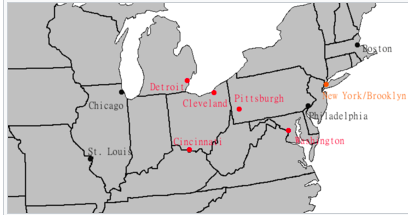
(Major Baseball Cities in the United States, 1919) 1. “History of Baseball in the United States.” Wikipedia, Wikimedia Foundation, 13 Feb. 2019.
When you ask any sports fan or even most common fans “who are the biggest rivals in sports” there is a pretty universal answer. That answer is the New York Yankees and the Boston Red Sox. Many people assume that the two teams always had this hatred for one another. But that is simply not the case. The mutual hatred for one another goes back over one hundred years with so many iconic moments. As well all know the Yankees are the most storied franchise in North American sports winning 27 championships since the early 1900’s when they were founded. They have one in almost every decade since the ’20s making them very easy to hate. But on the contrary, The Boston Red Sox are pretty historic themselves, winning the World Series nine times as well since their formation in 1901. But the rivalry had to start somewhere, no? The unofficial start to this historic rivalry began on December 26th, 1919. This was when the owner of the Boston Red Sox, Harry Frazee, fresh off a 1918 championship, sold George Herman Ruth to the New York Yankees for $125,000. 2.

(Yankees and Red Sox logos) 3. Leger, Justin, Nick Goss, and NBC Sports Boston Staff. “Red Sox and Yankees Receive Undisclosed Fines for Watchgate.” NBC Sports Chicago. September 15, 2017. Accessed February 20, 2019.
When talking about baseball greats, Babe Ruth is always one of the first names that comes to mind. This is a testament to how great of a player Babe Ruth was at this time. This was undeniable. As he was not as lethal of a hitter on the Red Sox that he would soon to be on the Yankees, there was no doubt in anybody’s mind at this time that Ruth was a star. Which is why many people were puzzled in regards to why they would trade their best player fresh off winning the World Series. But there a couple of different factors that led to his sale. Firstly, the answer was not for pure baseball reasons, but instead, financial reasons many people lead to believe. At the time Boston Red Sox Owner, Harry Frazee, was very involved with the theater industry. And many failures in 1918 left him in financial difficulties. So speculation then began that in order to make up for his losses, he decided to cut costs by selling off players from the Red Sox including Ruth himself. But this account is almost pure fiction actually. Yes, Frazee was very into theatrical productions. There was no denying that. But this account was almost pure fiction. 4.
Moreover, there were was way more that went into that deal than many historians and baseball fans may believe. While Frazee did sell Ruth and eventually broke up the core of his team, it had nothing to do with personal finances. It instead had a lot to do with Ban Johnson, the commissioner at the time, and political problems with baseball’s establishment. He believed Johnson was largely incompetent, and took it upon himself to take the sport into a new era. Johnson was not too fond of Frazee either and never wanted him in the league to start with. So when the Red Sox won in 1918, it gave Frazee the platform to openly criticize the World War one shortened mishandled season baseball just went through. The two clashed many times. Between umpire controversies, scheduling issues, Frazee almost buying the Giants as well (Johnson’s favorite team), and to the point where he went to the President of the United Sates, in William Howard Taft, to ask him if he can seize control of the league because Johnson was so inadequate. Tensions got so high, Johnson threatened to remove the American League all together. 5.
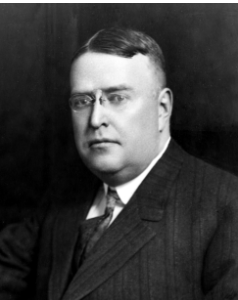
Photograph of former Commissioner of the MLB, Ban Johnson. (1919) 6. “Ban Johnson.” Ban Johnson | Society for American Baseball Research. Accessed May 07, 2019. https://sabr.org/bioproj/person/dabf79f8.
Frazee was not the only one with tensions with Commissioner Ban Johnson, the New York Yankees and Chicago White Sox did as well for separate issues regarding Johnson’s ability to run the MLB. Headlines soon came out in the New York Times that stated “Johnson’s Declaration of War on Frazee Threatens Eruption of League.” The article speculated that Frazee would not let Johnson oust him from baseball. Johnson hoped Frazee would just get angry enough to just sell the team. Both began a few month standoff hoping the other would fold by the end of 1918. Frazee sold some surplus in the minor league to the Yankees to form somewhat of an alliance against Johnson while both clubs were stronger. This deal made the Yankees more talented, while giving Frazee financial stability if a legal battle against Johnson began. 7.
As this was transpiring, the Red Sox still looked pretty strong to begin the 1919 season. They kept the core of their championship squad, including Ruth. But at the same time Ruth began to grow unhappy with his salary. He felt that he was underpaid and demanded more for his services. He wanted a one year, $15,000 dollar deal, or a 3 year, $30,000 deal. After telling Frazee his demands, he laughed in Ruth’s face. Every player at this time wanted more money and he played hardball with every single one of them. Over the course of the next few weeks the two began to go back and forth with another. Ruth threatened to retire and pursue boxing often. Frazee countered by threatening to trade the star in which they can receive a big haul in return for his services. You can obviously see where this was may be going. But shockingly enough, the two sides were able to agree to a 3 year deal, $30,000 deal like Ruth originally wanted, after both man got antsy after a few weeks of going back and forth. 8.
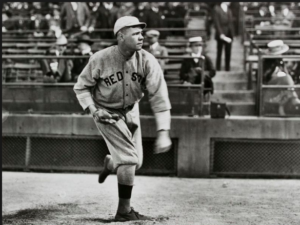
(Babe Ruth pitching in a game for the Boston Red Sox in 1919.) 9. Lewis, Danny. “This Digital Collection of Babe Ruth’s Scrapbooks Is a Piece of Home Run History.” Smithsonian.com. September 09, 2016. Accessed May 07, 2019. https://www.smithsonianmag.com/smart-news/digital-collection-babe-ruths-scrapbooks-piece-home-run-history-180960406/.
The season began just fine for the most part for both sides. But there was now another new issue beginning to present itself. This issue was whether Ruth was more effective as a pitcher, or as a batter. The Red Sox largely believed that he served better pitching, and that most of his 2018 batting success came in streaks and that his struggle against lefties proved he had many flaws at the plate. Ruth on the other hand believed he was more suited to hit with all of the power he now showcased. He belted a career high 29 home runs, beating out his previous career high in 11, while driving in 113 runs, and scoring 103 runs himself. At the same time he was also beginning to start problems in the clubhouse with managerial issues. A lot was going on this year that led to a rocky relationship between the franchise, and its budding star. 9.
Babe Ruth became an attraction in 1919. He was the only reason Red Sox Fans were coming out to Fenway Park, and he knew it. He was the main attraction at this point in time. The season was becoming a lost one as the Red Sox began to lose, and lose a lot. They finished the year at 66-71, which was bottom three in the American League. Not only this, was the fact Frazee began to send off players such Carl Mays, who grew tired of the team’s management and refused to play another game for the Sox before they sent him off to New York where he would go 9-3 to finish the year. At this same time tensions began to rise up between Johnson and Frazee as the two disagreed on how this issue was handled. It sparked their hatred for one another once again. Toward the end of the year Johnson was battling the Yankees in court over not letting Mays pitch partially toward the end of 1919. He was fighting one too many battles at the time and took a fatal blow losing the case which would be one he never recovered from. Although he lasted a few more years, he was determined to take whoever he could down with him. He saw the writing in the wall. 10.
With Ruth setting record in 1919 by boasting career highs, he was also flourishing off the field. Making money in exhibition games, from fans, and even going to Hollywood acting a bit. He would now demand a pay raise to double his salary to $20,000 for the 1920 season, or else he would sit out. He knew he was the center of the baseball world not only in Boston, but also throughout the league. But the Red Sox dropped to 5th in attendance that season due to poor play. Ruth knew the only reason people were coming out was for him. As these demands transpired, Frazee was battling Johnson at league meeting over many issues. Johnson still had support from his “Core 5” teams, and held a 5-3 advantage in all league meetings. Frazee was battling a war with Major League Baseball’s leader, while also dealing with his star player bickering throughout the year for so many different reasons. 11.
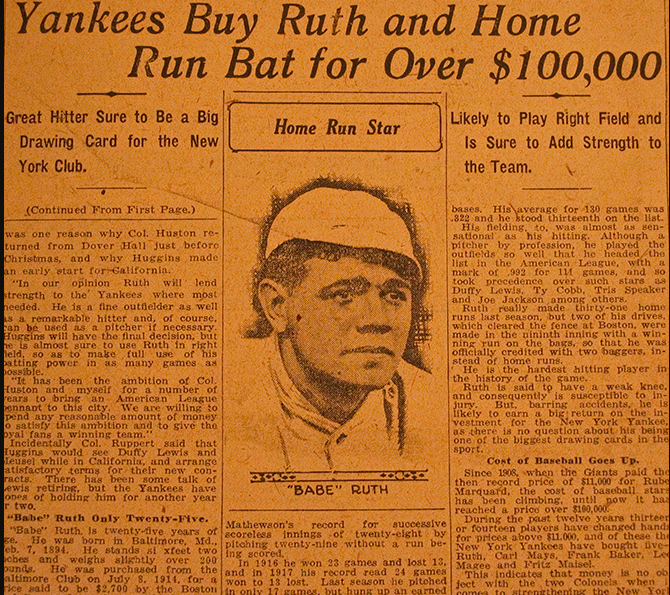
(Newspaper headline from New York World Newspaper, January 1920) 12. “YANKEES BUY BABE RUTH FROM THE BOSTON RED SOX!” The Mitchell Archives – Original Historic Newspapers. Accessed February 20, 2019.
So you may ask, how does any of the issues with Ban Johnson affect the sale of Babe Ruth? Well that answer is quite simple actually. With the legal battle now in full swing between Frazee, Johnson, and Major League Baseball, Frazee’s patience with Ruth finally reached a breaking point. As Boston sports media hinted at a possible sale of Ruth from December 21st-30th, they were not aware of what already happened. Four days earlier, on December 26th, Frazee already agreed to sell Ruth to the Yankees for a total of 125,000 dollars. On top of this, Rubert, owner of the Yankees, agreed to also help Frazee obtain loan or loan him 300,000 dollars, with Fenway Park as collateral. He may have received more from other clubs, such as the Cardinals, but his feud with Johnson’s “Core 5” did not allow him to test the waters for more lucrative offers. Frazee was pushed to the edge with all of the issues he was now dealing with and felt that this was the best move going forward in order for him to put all of his attention to the more pressing issue in his eyes. 13.
Frazee knew the backlash that this trade would generate. He released a 1,500 world statement on the matter stating that although Ruth was the best hitter the game ever seen, he was not worth the trouble he presented. A wide variety of issues stringing from his poor character, his selfishness, his constant managerial issues, pay increase demands, and the fact he always put himself above the team led him to make this deal. While local baseball figures such as Hugh Duffy, Bill Carrigan, and Fred Tenney all agreed with Frazee. But the media and fans did not share this common thought. There was outcry from the deal that only strengthened the superstitions that this was a way to save money and cut costs like they saw in the previous season. Many believed it was absolute blasphemy to deal someone who accounted for 90% of the team’s offense a year before. Trading away the best hitter the game had ever seen at this point, for straight up cash had many fans at their last straw in regards to ownership. The deal did not receive much love the moment it was announced, and what soon came after with Ruth’s arrival in New York only made it worse. As the team became a consistent loser for decades to come, the Yankees began to take off. 15.
But the magnitude of this trade would be felt for generations to come As a result of this the Red Sox became a regular in second place while the Yankees franchise took off. 16. He hit 50 plus home runs his first two years as a Yankees setting a MLB record each year. 17. He never hit less than 25 as a member of the Yankees. But his impact was not only felt on the field for the Yankees but also off the field. Babe Ruth became such a superstar and celebrity which was never seen in baseball before him. His popularity was so big it led to all-time attendance records and allowed the Yankees to move out of the Polo Grounds and build their own stadium which became Yankee Stadium. 18.

(Aerial view of Yankee Stadium as it looked from 1928 to 1936) 19. “Yankee Stadium (1923).” Hitchhiker’s Guide to the Galaxy on Opium Wars. Accessed February 20, 2019.
Yankee Stadium became known as, “The House that Ruth Built”, due to most of the revenue he brought in was used to fund the stadium being built. But what was truly remarkable about his time was the Yankees was the culture he built in the franchise. Before his arrival to the club the Yankees never won any sort of championship of any kind. While the Red Sox were the most successful team of the 20th century up to this point. But boy did the narratives change after this trade. He led the Yankees to seven American League Pennants and Four World Series titles. He was a part of possibly the best lineup ever created known as “Murderers Row” which was a collection of future hall of Famers such as Lou Gehrig, Earle Combs, Mark Koenig, Bob Meusel, Tony Lazzeri and Ruth himself who hit a new record 60 home runs. 20.
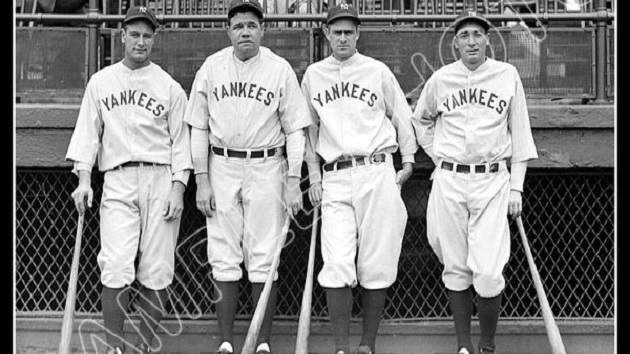
(Murderers Row, 1927 Yankees Home-Run Lineup) 21. Aronson, Harv. “Murderers’ Row Re-lived: Were the ’27 Yankees the Best? – TSP.” Prime Sports Net. April 28, 2018. Accessed February 20, 2019.
When looking back at this deal it is known as “The Curse of the Bambino” for good reason. It is well-known as one of the worst trades/sales of all time. Many consider Ruth to be the greatest baseball player of all time and certainly was the first recognizable star the sport ever saw. Ruth was a part of the inaugural 1936 Baseball Hall of Fame Class in Cooperstown, New York. He was a living legend. But aside from the man’s legacy the magnitude of this trade was because of the directions these two teams went after this trade. This began the curse of the Red Sox franchise. The team did not win a World Series for 85 straight years following the 1919 trade of Babe Ruth. Which almost everyone points as the reason why they could never win. Meanwhile the Yankees would go on to win 39 pennants, and 26 World Series during the time-span more than double any other team during that stretch. This curse would hold true until 2004 when in the American League Championship Series the Boston Red Sox overcame a 3-0 deficit to the New York Yankees in a best of 7 series to beat them 4 straight and later win the World Series in just 4 games. By beating these same Yankees in the only 3-0 comeback in the sports history and then to win it all for the first time since this trade was made was certainly the curse breaker. 22. All in all, the magnitude of this trade was astronomical. It changed the course of baseball history. It launched the beginning of the most successful North American sports franchise. But at the same time it also led to 80 plus years of Boston sports fan suffering. The exchange of Babe Ruth was one of the most, if not the most, lopsided trades in sports history.
Bibliography:
- 1. “History of Baseball in the United States.” Wikipedia, Wikimedia Foundation, 13 Feb.
2019.
2. “New York Yankees Announce Purchase of Babe Ruth.” History.com. November 16, 2009.
Accessed February 20, 2019.
3. Leger, Justin, Nick Goss, and NBC Sports Boston Staff. “Red Sox and Yankees Receive
Undisclosed Fines for Watchgate.” NBC Sports Chicago. September 15, 2017. Accessed February 20, 2019.
4. Stout, Glenn, and Dick Johnson. Red Sox Century: One Hundred Years of Red Sox Baseball. Norwalk, CT: Easton Press, 2001.
5. Ibid, Stout/Johnson.
6. “Ban Johnson.” Ban Johnson | Society for American Baseball Research. Accessed May 07, 2019.
https://sabr.org/bioproj/person/dabf79f8.
7. Ibid, Stout/Johnson.
8. Ibid, Stout/Johnson
9. Lewis, Danny. “This Digital Collection of Babe Ruth’s Scrapbooks Is a Piece of Home Run History.” Smithsonian.com. September 09,
2016. Accessed May 07, 2019. https://www.smithsonianmag.com/smart-news/digital-collection-babe-ruths-scrapbooks-piece-
home-run-history-180960406/.
10. Ibid, Stout/Johnson.
11. Ibid, Stout/Johnson.
12. “YANKEES BUY BABE RUTH FROM THE BOSTON RED SOX!” The Mitchell Archives –
Original Historic Newspapers. Accessed February 20, 2019.
13. Ibid, Stout/Johnson.
14. “Fans Differ in Regard to Sale of Babe Ruth”.” Newspapers.com/Boston Herald, January 6, 1920
15. Ibid, Stout/Johnson.
16. “No, No, Frazee: A Look Back at the Reaction Following Babe Ruth’s Sale to the Yankees.” The
Captain’s Blog. January 06, 2012. Accessed February 20, 2019.
17. GALLIAN, JOSEPH A. “Who Is the Greatest Hitter of Them All?” Math Horizons 10, no. 1
(2002): 13-28.
18. “Biography.” Biography | Babe Ruth. Accessed February 20, 2019.
19. “Yankee Stadium (1923).” Hitchhiker’s Guide to the Galaxy on Opium Wars. Accessed February
20, 2019.
20. “Babe Ruth’s Full Baseball Statistics.” Babe Ruth Central. Accessed February 20, 2019.
21. Aronson, Harv. “Murderers’ Row Re-lived: Were the ’27 Yankees the Best? – TSP.” Prime Sports
Net. April 28, 2018. Accessed February 20, 2019.
22. “New York Yankees 27 World Championships.” SI.com. Accessed February 20, 2019.

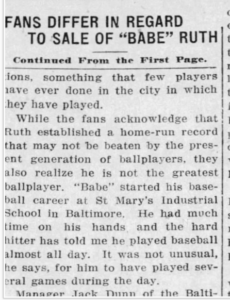
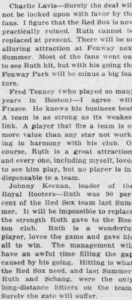
No Comments